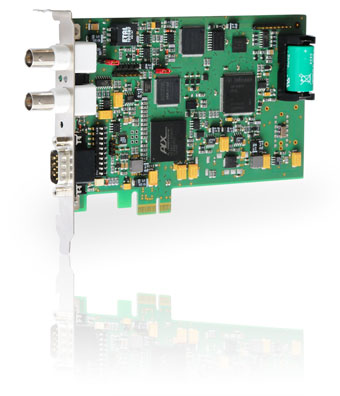TCR170PEX:
IRIG Time Code Receiver and Generator for Computers (PCI Express)
Key Features:
- Receives IRIG A/B or AFNOR time codes
- Generates IRIG B or AFNOR time codes
- Status LEDs
- DDS frequency synthesizer
- Programmable Pulse Outputs
- Two time-trigger inputs
- Memory Mapped I/O time reads for high access rates
- Configurable time zone
- Optional optical input and/or output for time codes
The Meinberg TCR170PEX synchronizes to IRIG-A/B or AFNOR time codes and provides precise time to the host PC. The IRIG output of this card can be used to synchronize other IRIG time code readers. The output format is independent from the incoming IRIG signal, and can be a convenient solution for IRIG conversion applications.
The TCR170PEX decodes and generates modulated (AM) and unmodulated (TTL/DCLS) IRIG and AFNOR time codes. It is equipped with a TCXO as ist standard onboard oscillator, and provides a high accuracy holdover rate of +/- 1 * 10E-8. An OCXO is optionally available for improved accuracy.
Receiver:
The module provides two input channels to decode modulated and unmodulated IRIG A, B or AFNOR time codes. The AGC allows synchronization to modulated IRIG signals within an amplitude range of 600 mVpp to 8 Vpp. The TCR170PEX can optionally be supplied with an optocoupler input to decode unmodulated codes with TTL- or RS-422 levels.
The decoded time and date are read by the PCI Express interface and also transmitted via the board’s RS-232 port. A buffered real time clock retains the time and date after power down.
Generator:
The TCR170PEX also generates IRIG B or AFNOR time codes. These output signals are modulated (3 Vpp/1 Vpp into 50 ohm) and unmodulated (TTL into 50 ohm and RS-422) time codes. An optical output for unmodulated codes is available as an option.
The generator’s time code output and offset to UTC can be configured independently of the receiver time, which allows the TCR170PEX to be used for time code conversion applications.



